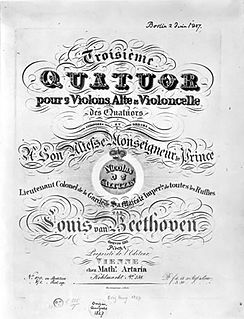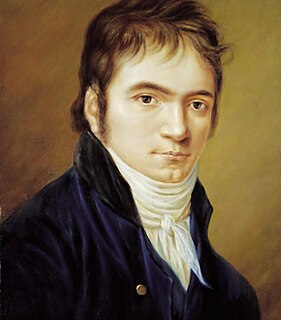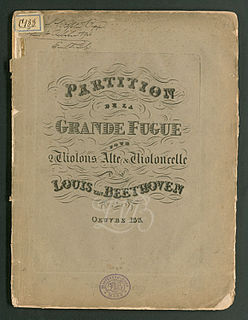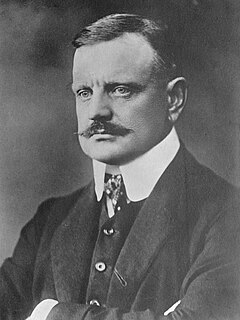Related Research Articles
Robert Wilfred Levick Simpson was an English composer and long-serving BBC producer and broadcaster.

The String Quartet No. 5, Sz. 102, BB 110 by Béla Bartók was written between 6 August and 6 September 1934. It is one of six string quartets by Bartok.

The String Quartet No. 1 in F major, Op. 18, No. 1, was written by Ludwig van Beethoven between 1798 and 1800, published in 1801, dedicated to the Bohemian aristocrat Joseph Franz von Lobkowitz. It is actually the second string quartet that Beethoven composed.

The String Quartet No. 14 in C♯ minor, Op. 131, was completed by Ludwig van Beethoven in 1826. It is the last-composed of a trio of string quartets, written in the order Opp. 132, 130, 131.

The String Quartet No. 13 in B♭ major, Op. 130, by Ludwig van Beethoven was completed in November 1826. The number traditionally assigned to it is based on the order of its publication; it is actually Beethoven's 14th quartet in order of composition. It was premiered in March 1826 by the Schuppanzigh Quartet and dedicated to Nikolai Galitzin on its publication in 1827.

The String Quartet No. 12 in E♭ major, Op. 127, by Ludwig van Beethoven, was completed in 1825. It is the first of Beethoven's late quartets.

The String Quartet No. 9 in C major, Op. 59, No. 3, was written by Ludwig van Beethoven and published in 1808. This work is the third of three of his "Razumovsky" cycle of string quartets, and is a product of his "middle" period. It consists of four movements:

The Grosse Fuge, Op. 133, is a single-movement composition for string quartet by Ludwig van Beethoven. An immense double fugue, it was universally condemned by contemporary music critics. A reviewer writing for the Allgemeine musikalische Zeitung in 1826 described the fugue as "incomprehensible, like Chinese" and "a confusion of Babel". However, critical opinion of the work has risen steadily since the early 20th century and it is now considered among Beethoven's greatest achievements. Igor Stravinsky described it as "an absolutely contemporary piece of music that will be contemporary forever."
Dmitri Shostakovich's String Quartet No. 1 in C major, Op. 49, was composed in six weeks during the summer of 1938. It carries no dedication.
Antonín Dvořák's Piano Quintet No. 2 in A major, Op. 81, B. 155, is a quintet for piano, 2 violins, viola, and cello. It was composed between August 18 and October 8, 1887, and was premiered in Prague on January 6, 1888. The quintet is acknowledged as one of the masterpieces in the form, along with those of Schumann, Brahms and Shostakovich.
The String Quartet No. 2 in A minor, Op. 13, was composed by Felix Mendelssohn in 1827. Written when he was 18 years old, it was, despite its official number, Mendelssohn's first mature string quartet. One of Mendelssohn's most passionate works, the A minor Quartet is one of the earliest and most significant examples of cyclic form in music.
Robert Simpson composed his Seventh Symphony in 1977, the same year he completed his Sixth Symphony. The work is dedicated to Hans Keller and his wife, Milein Keller, and was first performed by the Royal Liverpool Philharmonic Orchestra, conducted by Brian Wright at the Philharmonic Hall, Liverpool on 30 October 1984. It is a one-movement work of approximately 28 minutes duration, and since its first performance it has become one of Simpson’s most frequently heard symphonies.
The Symphony No. 9 by Robert Simpson was composed between 1985 and 1987 and commissioned by the Bournemouth Symphony Orchestra who gave the premiere under Vernon Handley at the Poole Arts Centre on 8 April 1987. The work was dedicated to his second wife, Angela. It has been called ‘the largest piece of music written in one tempo’ and, more than any other Simpson symphony, met with immediate critical acclaim. Some music critics and admirers of Simpson’s music consider this symphony to be his finest.
The String Quartet No. 9 by Robert Simpson was written in response to a commission by the Delme Quartet in 1982 to mark their 20th anniversary, one which coincided with the 250th anniversary of the birth of Joseph Haydn. Simpson was among five British composers to write works to mark this dual occasion, producing a very large set of variations on a Haydn theme, a work of some fifty-seven minutes in duration. Its first performance was given in the Wigmore Hall in London on 6 October 1982.

The six string quartets opus 20 by Joseph Haydn are among the works that earned Haydn the sobriquet "the father of the string quartet". The quartets are considered a milestone in the history of composition; in them, Haydn develops compositional techniques that were to define the medium for the next 200 years.
String Quartet No. 4 by Walter Piston is a chamber-music work composed in 1951.

Gabriel Fauré's Piano Quartet No. 1, in C minor, Op. 15, is one of the two chamber works he wrote for the conventional piano quartet combination of piano, violin, viola and cello. Despite being in a minor key it is predominantly positive in tone, though with some hints in the slow movement of the emotional turmoil of Fauré's life at the time of the composition. The first piano quartet is considered one of the three masterpieces of his youth, along with the first violin sonata and the Ballade in F♯ major.
The String Quartet in D major is the only string quartet composed by César Franck. The work was written from 1889 to 1890.

Voces intimae, Op. 56, is a five-movement string quartet written in 1909 by the Finnish composer Jean Sibelius. He composed the work in D minor. It is the only major work for string quartet of his mature period.

Gabriel Fauré's Piano Quartet No. 2, in G minor, Op. 45, is one of the two chamber works he wrote for the conventional piano quartet combination of piano, violin, viola and cello. It was first performed in 1887, seven years after his first quartet.
References
- ↑ "String Quartet No 8 (1979)". Faber Music.
- 1 2 3 4 5 6 7 8 Lionel Pike (1984). "Robert Simpson (1921-1997) String Quartets Nos 7 & 8". Hyperion Records.
- 1 2 "Robert Simpson (1921-1997)". Ear Sense.
- ↑ "Robert Simpson Discography" . Retrieved October 19, 2011.